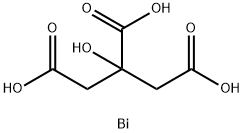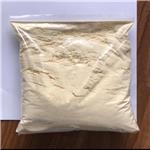Description
Bismuth subcitrate, a complex of citrate and bismuth at a molar ratio of 2:1, commercially available as tri-potassium bismuth subcitrate (CAS 57644-54-9), molecular formula C12H10BiK3O14. In particular, this substance is sometimes mixed up with bismuth citrate in the open literature and also in the dossier and some of the studies provided.
Colloidal bismuth citrate or colloidal bismuth subcitrate (CBS), a polyanionic structure of [Bi(cit)2Bi]n2n?, which is commercially used in pharmaceutical preparations (see Functions and Uses) (Ref. 1). The reported bismuth content of CBS is 35.5% (Ref. 65, Tab.2); in another reference, 36.0% bismuth content was found (ref 63).
Ranitidine bismuth citrate (Tritec® and Pylorid® GSK), a pharmaceutical preparation consisting of colloidal bismuth subcitrate and ranitidine molecules encased in the crystal latter.
ref 1, Yang N, Sun H (2007) Biocoordination chemistry of Bismuth: Recent Advances. Coordination Chemistry Reviews,251, (17-20), 2354-2366
ref 63, Dresow B et al. (1991). Bioavailability of bismuth from 205Bi-labelled pharmaceutical oral Bi-preparations in rats Arch Toxicol, 65(8):646-50
ref 65, Slikkerveer A, Helmich R B, van der Voet G B, de Wolff FA. Absorption of bismuth from several bismuth compounds during in vivo perfusion of rat small intestine. J Pharm Sci. 1995 Apr 84 (4) 512-5
Chemical Properties
White Crystalline Powder
Uses
Bismuth citrate has been in use as a progressive hair dye in the USA for some time and Grecian Bismuth was launched in Europe in 2005 (approximately 6 million units sold) and in Canada in 2008 (approximately 175,000 units sold). Bismuth citrate will be incorporated in progressive hair dye formulations at a maximum concentration of 2.0%. In the USA up to 0.5% are permitted.
Progressive hair dyes work gradually, with colour build-up over a period of two to three weeks of daily application. This hair dye changes the colour of hair from grey to darker shades by reacting with the sulphur of hair keratin as well as oxidizing on the hair surface. With such application, the hair gradually darkens until the required shade is achieved. Thereafter, colour is maintained by up to 3 applications per week. This product is intended for use by middle-aged and older people, principally men. The principle of coloration from bismuth citrate has been described in section 1, Background.
Bismuth is one of the medicinal drugs referenced in Pharmacopoeias, with bismuth compounds used topically or orally for indications such as minor stomach-aches, ulcers and venereal diseases for over 200 years.
Bismuth compounds have been used as antimicrobial agents for:
syphilis (e.g. sodium/potassium bismuth tartrate, bismuth quinine iodide, iododbismol, bismuth chloride)
colitis (e.g. bismuth citrate, bismuth subnitrite)
wound infection (e.g. bismuth oxide)
quartan malaria (e.g. sodium bismuth thioglycolate)
dyspepsia (e.g. bismuth subsalicylate, bismuth subnitrate) and
peptic ulcers (e.g. colloidal bismuth subcitrate, bismuth citrate, bismuth subnitrate).
ec.europa.eu
Uses
Bismuth(III) citrate has been used as a sorbent in spin columns to develop a novel stationary phase for the selective and efficient isolation of phenolic compounds from natural sources via solid phase extraction (SPE) method. It can be used to synthesize bismuth subcarbonate ((BiO)
2CO
3) nanotubes that are reported to show antibacterial property against
Helicobacter pylori.
Uses
Bismuth citrate is used as a progressive hair dye in cosmetics. It is used as antimicrobial agents for syphills, colitis, wound infection, quartan malaria, dyspepsia and peptic ulcers.
Definition
ChEBI: Bismuth citrate is it is a colour additive. It contains a citrate(3-).
Flammability and Explosibility
Non flammable
reaction suitability
core: bismuth
reagent type: catalyst



